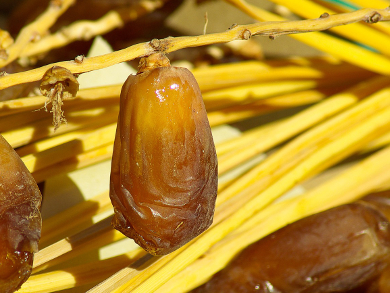This evening, Ramadan will begin, a month during which Muslims abstain from eating and drinking from sunrise to sunset. Date fruits are a traditional part of the evening meal breaking the fast (called “iftar”). Here, we take a look at dates from a chemical and nutritional perspective.
Date fruits take about 200 days to fully grow and ripen, and their ripeness is classified as either kimri (unripe), khalaal (full-sized), rutab (ripe, soft), or tamr (ripe, sun-dried). During the ripening process, the moisture content decreases and the sugar content increases. Below a moisture content of around 25 %, the dates are self-preserving.
An average date in the tamr stage weighs about seven to ten grams and has about 20 kcal. These calories stem almost entirely from the sugar contained in the fruit in the form of sucrose, glucose, and fructose. During ripening, sucrose is converted to glucose and fructose by the enzyme invertase. Dates also contain small amounts of fat (mostly in the skin) and protein (roughly 1–3 %).
Dates are a good source of dietary fiber, with over half a gram per dried fruit. While these fibers are indigestible by humans, they have healthy effects such as curbing appetite and regulating blood sugar and digestion. The fruit also provides minerals such as potassium, calcium, and iron.
In addition, fresh dates are especially rich in phenolic antioxidants, which scavenge free radicals and may protect the health of cells and reduce inflammation. Specifically, dates have been shown to contain benzoic acids, cinnamic acids, flavonoid glycosides and esters, flavan-3-ols, and proanthocyanidins, which all belong to the phenolic compounds. So overall, while dates are rich in sugar, they deliver a whole range of healthy nutrients.
Ramadan Mubarak! Ramadan Kareem!
Sources
- Date fruit (Phoenix dactylifera L.): An underutilized food seeking industrial valorization,
Sami Ghnimi, Syed Umer, Azharul Karim, Afaf Kamal-Eldin,
NFS J. 2017, 6, 1–10.
DOI: 10.1016/j.nfs.2016.12.001 - Date Palm Products,
W. H. Barreveld,
Food and Agriculture Organization of the United States (FAO) Agricultural Services Bulletin, 101, 1993.


